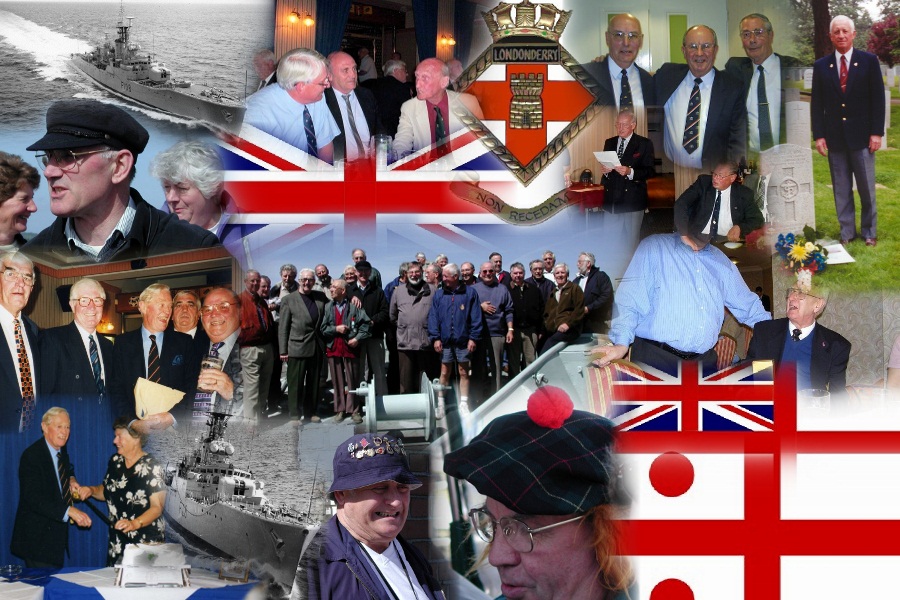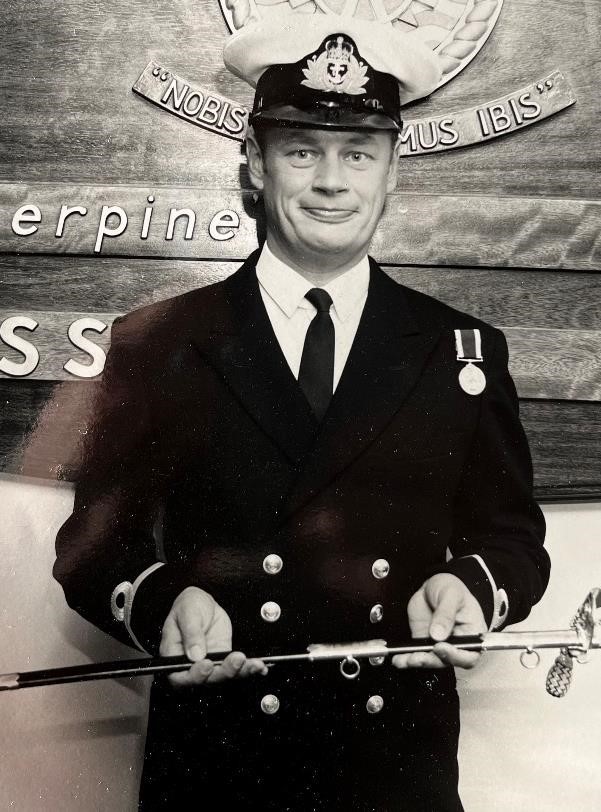


For a small ship in peacetime HMS Londonderry appears to have had a high number of officers who reached either senior officer or flag rank, and a creditable number of ratings that later achieved commissions and senior officer rank during their careers in the Royal Navy. Three officers retired with Rear Admiral Rank, two ratings achieved Commander, three Lieutenant Commander, and three Lieutenant, plus one Merchant Navy Deck Officer.
Lieutenant Bevan promoted Lt. Cdr. during 1st Commision retired with the rank of Rear Admiral. (Biography below culled from The Daily Telegraph).
Lieutenant Layman who commanded HMS Argonaut during the Falklands war retired with the rank of Rear Admiral (Wikipedia details below).
Sub Lieutenant Cooke-Priest promoted Lieutenant during 1st Commission retired with the rank of Rear Admiral (RN Biography below).
Sub Lieutenant Wigley was tragically killed in an helicopter accident (HMS Osprey) at the rank of Captain.
Petty Officer GI McKeon on leaving the Londonderry, qualified as Sub Lt.(G) and his drafts included HMS Chichester and Penelope and also HMS Fisguard. He voluntarily retired in 1969 and went to South Africa and later joined the SAN as a Lt. He served aboard SAS Simonsberg. Was 1st Lt. aboard SAS President Pretorius, a Type 12, so he was at home in her. He was XO of SAS Scorpion the Strike Craft Flotilla Base, Durban. He retired in 1990 with the rank of Commander.
Able Seaman O'Callaghan promoted Leading Seaman then A/Petty Officer during 1st Commission. Retired as Commander.
Able Seaman Peter Greenhalgh

Radio Supervisor Cahill after Londonderry, qualified as S/Lt (C). He served aboard HMS Nubian, on the Staff of FO Gib. Retired as Lieutenant Commander(C).
Front Row, Extreme Right.SA(V) Allington did a second tour of duty aboard Londonderry in 1971/72 but this time as the Supply Lt. He retired as Lieutenant Commander.
Junior Seaman Wilcox to Lieutenant Commander.
Able Seaman Hessey promoted Leading Seaman during 1st Commission remembers that in 1952, when a boy seaman at HMS St. Vincent, Commander Primrose was then the Gunnery Officer & says he was quite used to being shouted at by him. He retired in 1994 after 42 years service with the rank of Lieutenant(G).
REA2 Boxall to Lieutenant(E)
Able Seaman Brown (PTI) promoted Leading Seaman during 1st Commission became Chief PTI then Lieutenant, completing service as RN Careers Officer.
Able Seaman George (Chippy) Baldwin became a trawler skipper fishing out of Scarborough and then a deck officer onboard rig supply and stand-by vessels out of Aberdeen.
Rear Admiral Tim Bevan CB (1931-2019)
Joined Royal Navy 1949; specialized in Torpedo and Anti-Submarine Warfare; commanded HM Ships: Decoy (1966), Caprice (1967), Minerva (1971-72), Ariadne (1977), Ajax (1980), Ariadne - Captain 8th Frigate Squadron (1980-82).
He also served in various capacities aboard HM Ships and Shore Establishments including HMS Glasgow, HMS Superb, HMY Britannia (1954), Flag Lieutenant to CinC Mediterranean (1957-58), HMS Londonderry (TASO) 1960-62, Royal Naval College Greenwich - Directing Staff (1973), HMS Excellent (1974-75), Asst. Dir. of Defence Policy MOD (1978-80), Captain Britannia Royal Naval College, Dartmouth (1982-84), Asst. Chief of Defence Staff (Intelligence) (1984-86).
On retirement he became Chief Operations Officer at Vigers, a commercial property company in London and later at Action for the Communities of Rural England, a charity promoting the maintenance of strong village life. Rear Admiral Bevan in retirement settled in rural Gloucestershire. His wife Sarah pre-deceased him in 2016 and he is survived by his three sons.
Rear Admiral C H Layman, CB, DSO, LVO.
Joined Royal Navy, 1956; specialised Communications and Electronic Warfare, 1966; commanded HM Ships: Hubberston, 1968–70; Lynx, 1972–74; Exec. Officer, HM Yacht Britannia, 1976–78; Captain, 7th Frigate Sqn, 1981–83; commanded HM Ships: Argonaut, 1981–82; Cleopatra, 1982–83; Invincible, 1984–86; Asst Dir (Communications and Information Systems), IMS, NATO HQ, Brussels, 1988–91, retd. Consultant in communications and inf. systems and maritime affairs, 1991–2001. Gentleman Usher of the Green Rod, Order of the Thistle.
Captain Christopher Layman commanded the Frigate HMS Argonaut during the Falklands campaign.
HMS Argonaut (F56) was a Leander-class frigate of the Royal Navy. She was built by Hawthorne Leslie of Hebburn. She was launched on the 8th February 1966 and commissioned on the 17th August 1967.
In 1982 the Falkland Islands were invaded by Argentina. An advanced group of British vessels began to steam towards Ascension Island on the 2nd April, a territory that would play a strategic part in the eventual liberation of the Falkland Islands. On the 19th April, Argonaut, along with Ardent and two RFA ships Regent and Plumleaf finally headed for Ascension Island. On the 29th, the group finally arrived at Ascension, and on the 6th May the Argonaut Group departed the island for the Falklands.
On the 16th, the Group joined the large Amphibious Group centred around Fearless and Intrepid, and on the 18th the Group met up with the Carrier Battle Group. On the 21st, Argonaut, along with other destroyers and frigates, provided close escort for the amphibious vessels during the successful San Carlos Landings.
On that day, Argonaut was attacked twice by Argentinian aircraft. The first attack caused some damage, including to her Type 965 Radar, while the second attack was launched by six fast A-4 Skyhawks. Two bombs hit Argonaut. Neither exploded, though unfortunately one of the unexploded bombs killed two sailors, Able Seaman Iain M. Boldy and Able Seaman Matthew J. Stuart, when it entered the ship's Sea Cat missile magazine, detonating two missiles. Plymouth came to the assistance of Argonaut and towed her away from immediate danger.
Both bombs were still active, and it took a number of days to deactivate them, as this was very risky work, proven on the 24th May when Antelope sank after an unexploded bomb detonated while experts were attempting to deactivate it.
On the 20th June, the Falklands were liberated and the war was declared over. On the 26th June, Argonaut finally returned home to Devonport Dockyard after a long journey, where she underwent repairs for her battle damage. During the repairs, new sonar equipment was fitted.
www.wikipedia.org
Rear Admiral Colin Cooke-Priest, CB, Commander RVO, FRAeS
Colin Cooke-Priest entered the Royal Naval College, Dartmouth, in 1957. After service worldwide in a variety of major warships, he joined the Observer School at the Naval Air Station Hal Far, Malta, in 1962 and gained his 'wings' the following year. Flying anti-submarine helicopters with 814 Squadron in HMS VICTORIOUS and HMS ALBION, he saw service in Aden, the Far East and in Borneo during the confrontation with Indonesia.
After a tour as Operations Officer in HMS RUSSELL, he served in the Royal Australian Navy for a two year exchange appointment with 817 Squadron in the aircraft carrier HMAS MELBOURNE. On return he was appointed Senior Observer of 824 Squadron in HMS ARK ROYAL and then as Senior Instructor at the Naval Observer School.
Colin was promoted to Commander in 1973 and in that rank commanded the frigates HMS PLYMOUTH and HMS BERWICK before taking over the 'Future Helicopter' desk in the Directorate of Naval Air Warfare.
In 1979 he was appointed Naval Assistant to the Commander-in-Chief Fleet. He was promoted Captain during this appointment and then returned to the Ministry of Defence as Assistant Director of Naval Air Warfare. His subsequent appointments included Director of the Maritime Tactical School and command of the Type 22 frigates HMS BOXER and HMS BRILLIANT as Captain Second Frigate Squadron. In 1988 he commanded the Royal Naval 'Armilla' Task Force in the Gulf.
He was promoted Rear Admiral in 1989 on his appointment to SHAPE, Belgium as Deputy Assistant Chief of Staff (Operations) and Maritime Advisor to Supreme Allied Commander Europe. He became Flag Officer Naval Aviation in December 1990, serving in this appointment until his retirement from the Navy in 1993.
On leaving the Navy he spent five years as the National Director (CEO) of the Trident Trust, an educational charity whose principal activity was placing over 150,000 young people annually in work experience from 60 offices around the Country.
Colin was a member of the Guild of Air Pilots and Air Navigators. Also a Liveryman of the Worshipful Company of Coachmakers and Coach Harness Makers, a Freeman of the City of London and a Fellow of the Royal Aeronautical Society. He was a Life Vice President of the Fleet Air Arm Officers' Association and a former Trustee of the Aviation Scholarship Trust, the Fleet Air Arm Museum, the RN Historic Flight and Canine Partners (an Assistance Dog charity). Colin was appointed CB in 1993, and CVO and an Extra Gentleman Usher to HM The Queen in 2009.
Colin met his wife Sue at RNAS Hal Far, Malta, where she was serving as a Communications Wren. He is survived by Sue, two sons and two daughters, one of whom is a serving Naval Officer.
|
|